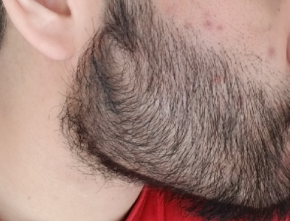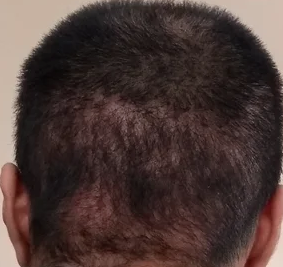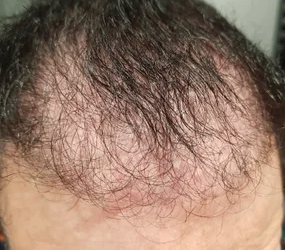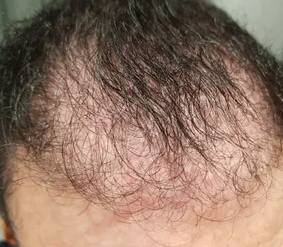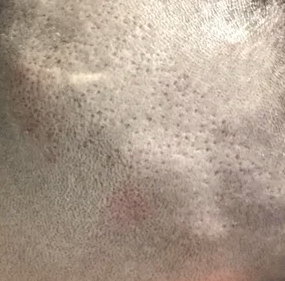 This is an important book to read for those of you who are experiencing hair loss from a man who went through it. He discusses the pitfalls in the commercial side of the hair transplant business which you should all know about. John Vincent has offered our readers a free copy of the book by emailing him here:
This is an important book to read for those of you who are experiencing hair loss from a man who went through it. He discusses the pitfalls in the commercial side of the hair transplant business which you should all know about. John Vincent has offered our readers a free copy of the book by emailing him here:
| John Vincent <john@hairconsultant.com> |
It is too early to tell much. Your hairline is still in its juvenile position (because it approximates the highest crease of the furrowed brow) and I would expect that it would rise about 1/4 inch from where it is. Maybe what you are seeing on the right side is the first step in this process. If I were to see you, I would look to see if you had miniaturization in the frontal area, which would indicate changes coming.
I don’t believe that finasteride will impact brain development.
This is a failure of the transplant unless your surgeon placed far less than the 2200 grafts you reported. I would go back to have a frank discussion with your surgeon as you paid good money to have this done. The most frequent reasons for hair transplant failure, is some technical glitch or lack of experience by the surgeon and/or his team!
I addressed the question by suggesting that they check me out in the medical board offices of the States of California, New York and Florida where I am licensed. I thought I would share some of my recent awards with you in case you have any doubt. These include Best Doctor in the United State for hair transplantation by Castle Connolly (see here:https://www.castleconnolly.com/about/NomProcess.cfm ) for 10+ consecutive years, the Golden Follicle Award (see here: https://newhair.com/wp-content/uploads/2018/11/nhi-newsletter-2005.pdf), Two Life Time Achievement Awards presented in 2019 (by South American and European Societies).
I guess the answer to the question is that I must be licensed to practice medicine or I am a hell of an impostor.
I give the patient a surgical sponge that has no soap in it. The patient then wets his recipient area with softly running water. Any good shampoo can be used with the sponge. Put shampoo into a small bowl of water and then using the sponge, make a lot of suds so that it fills with shampoo. Then with a rolling motion (back to front, not rubbing), press the sponge on the recipient sites so the soap from inside the sponge squirts on the grafts as you press on the sponge holding a mild pressure on the grafts. A back to front rolling motion is best. This process is repeated until all of the crusts are off provided that it is started the day after the surgery. If there are some persistent scabs, use a Q-tip dipped into the bowl. Roll the a-tip over the scab until it comes off. The cotton in the Q-tip will pull off the scabs as you roll in over the scab. If you wait too long, the crusting (scabbing) gets fixed to the scalp and then there is a new problem, how to get off the crusts that have been there for a few days as these grafts are then fixed to the scalp. If you pull them off at this point in time, the grafts will come out. Read this article: https://newhair.com/wp-content/uploads/2018/11/mp-2006-graft-anchoring.pdf
When you say pencil size from the 1980w, you mean the shaft of a pencil? Presumably this little bit of tissue had several follicles? When I heard the term in the past I thought they were little wigs you wore in the receded area!
A hollow drill was used in the back of the head that cored out a pencil size plug of hair. These were placed in the front in rows. Only a quarter of an area was covered with each of four surgeries with the idea that when eventually filled in, the four quarter patterns would cover the balding areas. Unfortunately, the idea was flawed, because after the plug was put into the scalp, it would contract squeezing the plug to a very high hair density. The the central part, would die off so that the plug looked like donuts. With these high density plugs surrounding a hole in the center, the unfortunate victims has a pattern of hair plugs that anyone could see within 20 feet. I, personally, can’t believe that the public accepted this result, but they did, maybe because they felt that a dolls head of hair was better than a bald head of no hair.
Before one gets a hair transplant you have to:
1-be balding
2- be over the age of 26 so that your hair loss pattern is defined
3- be prepared financially for more hair loss and more hair transplants
4- failed on conservative treatments like minoxidil and/or finasteride
5- My saying is: A good decision today is a good decision tomorrow’ that tells you that you should think more than once about doing hair transplants and make sure this is the right solution for you.
I’m just wondering something. I’m in my early 30s now and always dreaming of a hair transplant. Maybe the older guys know an answer to this question: do you think (good) hair transplants will get more affordable and better in the future? I know that in the past it was mostly FUT so I think FUE is definitely a step up. But I’m wondering if there’s still room for improvement besides this procedure so one can hope. I’m not talking about unrealistic stuff (stem cells, yeah been hearing this for years now…) but just for more efficient ways that are in development? How has the industry changed over the last ten years and what can we expect for the next ten?
The procedure for hair transplants is now very efficient and that is why it is becoming more popular. This is a rapid growth industry now growing in excess of 20% per year, as high as 65% in some areas of the world. We have not tapped the balding market yet, but the number one problem is dishonest representations of the goals that are realistic, often pushed by salesmen employed by somewhat unscrupulous doctors. Young men, in particular, tend to fall for the lines of the salesmen that work for doctors who hustle for business and may get commissions for closing the sale (this could be you). Let the buyer beware.


